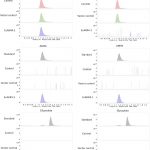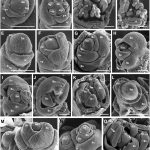Jasmonic Acid and High Light and Heat Stress
Plants often experience high light (HL) intensities in the field, many times in conjunction with elevated temperatures. Such conditions are a serious threat to agriculture production, because photosynthesis is highly sensitive to both HL intensities and high-temperature stress.  During HL stress, the reaction centers become saturated and the excess excitation energy can become harmful because it can irreversibly damage PSII. In plants, PSII contains more than 20 subunits including four major core subunits, one of which, termed “D1” (PsbA), is the main site susceptible to damage by HS or HL. Damage to PSII leads to photoinhibition—a sustained decline in photosynthetic efficiency caused by the imbalance between the rate of photodamage to PSII and the rate of PSII repair. In addition to HL stress, HS can compromise PSII electron transport due to the increase in fluidity of the thylakoid membranes, which causes dislodging of PSII light harvesting complexes (LHC) and decreased integrity of PSII. HS can also impair the repair process of PSII, exacerbating the effects of HL stress. Balfagón et al. (10.1104/pp.19.00956) have studied the responses of Arabidopsis (Arabidopsis thaliana) plants to a combination of HL and HS (HL+HS) conditions. Combined HL+HS was accompanied by irreversible damage to PSII, decreased D1 protein levels, and an enhanced transcriptional response indicative of PSII repair activation. They further identified several unique aspects of this stress combination that included enhanced accumulation of jasmonic acid (JA) and its conjugate form JA-Ile, as well as the elevated expression of over 2,200 different transcripts that are unique to the stress combination (including many that are JA-associated). HL-induced structural changes to chloroplasts included a decrease in the number of starch granules and enhanced stacking of thylakoids (number of thylakoid membranes. In contrast, chloroplasts of HS-treated plants contain a higher number of starch granules and exhibit reduced granal stacking. A mutant deficient in JA biosynthesis (allene oxide synthase) displayed enhanced sensitivity to combined HL+HS. This study reveals that JA plays an important role in the acclimation of plants to a combination of HL+HS.
During HL stress, the reaction centers become saturated and the excess excitation energy can become harmful because it can irreversibly damage PSII. In plants, PSII contains more than 20 subunits including four major core subunits, one of which, termed “D1” (PsbA), is the main site susceptible to damage by HS or HL. Damage to PSII leads to photoinhibition—a sustained decline in photosynthetic efficiency caused by the imbalance between the rate of photodamage to PSII and the rate of PSII repair. In addition to HL stress, HS can compromise PSII electron transport due to the increase in fluidity of the thylakoid membranes, which causes dislodging of PSII light harvesting complexes (LHC) and decreased integrity of PSII. HS can also impair the repair process of PSII, exacerbating the effects of HL stress. Balfagón et al. (10.1104/pp.19.00956) have studied the responses of Arabidopsis (Arabidopsis thaliana) plants to a combination of HL and HS (HL+HS) conditions. Combined HL+HS was accompanied by irreversible damage to PSII, decreased D1 protein levels, and an enhanced transcriptional response indicative of PSII repair activation. They further identified several unique aspects of this stress combination that included enhanced accumulation of jasmonic acid (JA) and its conjugate form JA-Ile, as well as the elevated expression of over 2,200 different transcripts that are unique to the stress combination (including many that are JA-associated). HL-induced structural changes to chloroplasts included a decrease in the number of starch granules and enhanced stacking of thylakoids (number of thylakoid membranes. In contrast, chloroplasts of HS-treated plants contain a higher number of starch granules and exhibit reduced granal stacking. A mutant deficient in JA biosynthesis (allene oxide synthase) displayed enhanced sensitivity to combined HL+HS. This study reveals that JA plays an important role in the acclimation of plants to a combination of HL+HS.



